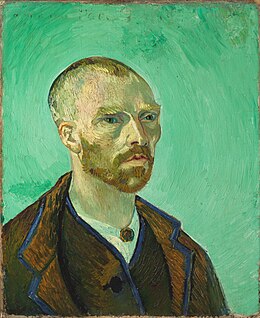Autoportrait dédié à Paul Gauguin
 From Wikipedia (Fr) - Reading time: 4 min
From Wikipedia (Fr) - Reading time: 4 min
| Artiste | |
|---|---|
| Date | |
| Type | |
| Matériau | |
| Lieu de création | |
| Dimensions (H × L) |
61,5 × 50,3 cm |
| Propriétaire | |
| No d’inventaire |
1951.65, 16554, 1951.65 |
| Localisation |
Fogg Art Museum, "degenerate art" collection (d) |
Autoportrait dédié à Paul Gauguin est un tableau réalisé par le peintre néerlandais Vincent van Gogh en 1888 à Arles, dans les Bouches-du-Rhône, en France. Cette huile sur toile est un autoportrait dans lequel l'artiste se représente en buste sur un fond vert (composé principalement d'un mélange de blanc de zinc et de vert de Paris[1]). Dédiée à son confrère Paul Gauguin par une inscription près du bord supérieur de la composition, l'œuvre est conservée depuis 1951 au Fogg Art Museum, à Cambridge, dans le Massachusetts, aux États-Unis.
Liens externes
[modifier | modifier le code]
- Ressources relatives aux beaux-arts :
- (en) Self-Portrait Dedicated to Paul Gauguin, site web des musées d'Art de Harvard
Références
[modifier | modifier le code]- ↑ (en) Vojtěch Jirat-Wasiutyński, H. Travers Newton, Eugene Farrell et Richard Newman, Vincent van Gogh's Self-Portrait Dedicated to Paul Gauguin. A Historical and Technical Study, Cambridge, Massachusetts : Center for Conservation and Technical Studies, Harvard University Art Museums, , p. 33-34 :
« Van Gogh used two green pigments in this painting: emerald green and viridian (in addition to the mixed “chrome green” noted above). Emerald green […] is known historically by several names, including Paris green, Schweinfort green, and vert veronèse. It was referred to as “vert veronèse” in van Gogh’s letters; (…) Emerald green occurs in the background of the portrait and was found in small amounts in samples from several other points. Identification of this pigment was made by comparison of the X-ray diffraction patterns with those of standard emerald green from the Forbes Pigment Collection (Fogg Art Museum). (…) The background of the painting consists of emerald green and zinc white with a small amount of lead white. »
 KSF
KSF